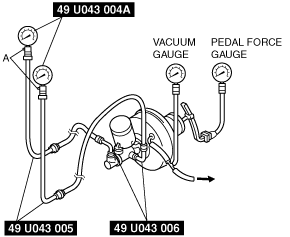 |
POWER BRAKE UNIT INSPECTION
id041100801700
Power Brake Unit Function Inspection (Inspection using gauges)
1. Connect the SST gauges, a vacuum gauge, and a pedal depression gauge as shown in the figure. Bleed the air from the SST gauges before performing the following tests.
dbr411zwb019
|
Checking for vacuum loss (unloaded condition)
1. Start the engine.
2. Stop the engine when the vacuum gauge indicates 67 kPa {500 mmHg, 20 inHg}.
3. Observe the vacuum gauge for 15 s.
Checking for vacuum loss (loaded condition)
1. Start the engine.
2. Depress the brake pedal with a force of 200 N {20 kgf, 45 lbf}.
3. With the brake pedal held depressed, stop the engine when the vacuum gauge indicates 67 kPa {500 mmHg, 20 inHg}.
4. Observe the vacuum gauge for 15 s.
Checking for hydraulic pressure
1. If the engine is stopped (vacuum 0 kPa {0 mmHg, 0 inHg}) and the fluid pressure is within the specification, the unit is operating.
2. Start the engine. Depress the brake pedal when the vacuum reaches 67 kPa {500 mmHg, 20 inHg}.